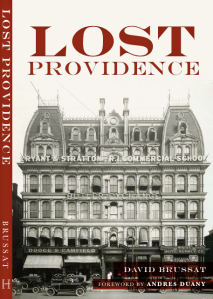
This post corrects my lapse in failing to pass along the Sunday, Oct. 15 review of my book in the newspaper I worked at for three decades. Lost Providence was reviewed by Patrick Conley, the historian laureate of Rhode Island. His article, “Vanished landmarks,” received prominent play in my old paper, including an illustrated skybox (“Where Providence Used to Be”) on Page One, and placement above the fold on the first page of the book section, with a large illustration and a thumbnail of the book, jumping to an inside page of The Rhode Islander with two more large illustrations. (The treatment online, linked above and headlined “Book review: ‘Lost Providence’ is a real find for architecture buffs,” was equally robust.)
The placement by Journal book editor Esther Gross was most gracious and personally gratifying, but the review itself, which she solicited from Conley, warmed the cockles of my heart. My favorite line is “Brussat has produced a worthy successor to and update of the magisterial ‘Civic and Architectural Development of Providence,’ published by architectural historian John Hutchins Cady in 1957.”
My thanks to Conley for making the comparison. Cady’s richly detailed and comprehensive volume reminds us all of how much we Rhode Islanders, so infatuated by our city’s history and its architecture, have forgotten about its development. Cady’s book is out of print but usually fetches at least $100 in used bookstores, but I was startled to discover that it may be had for $35 on Amazon (linked above). Conley’s book, Providence: A Pictorial History, written with Paul Campbell, who later became the city’s archivist, is another great book I used to write my book. The book that was most useful in researching the city’s development history since 1957 is Providence: The Renaissance City, by Francis Leazes Jr. and Mark Motte. Both are available on Amazon.
***
Speaking of Amazon, the first person to “review” my book there stated that she had ordered the book but was instead sent a set of 15 postcards from the book that my publisher, The History Press, sells separately. Her review just states her complaint and expresses her understandable pique by granting a mere two stars (out of five) to the book itself, which she clearly had not read. Since those who go to Amazon to buy the book will see her two stars, that misleading assessment is likely to reduce sales drastically unless others send in their own reviews to balance things out.
So, readers of this blog who have also read the book, please write a review, however brief, on its Amazon page. You will earn its author’s undying gratitude!


